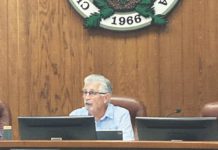Tap water in Scotts Valley now costs more than it did a week ago, about 27 percent more for a typical household.
New water fees under discussion and review for several months were finally approved by the Scotts Valley Water District’s Board of Directors on Monday, Dec. 12 and went into effect the next day.
A family that uses 8,000 gallons of water in two months – the district’s median for a single family – paid $83.96 on its last bill. The new two-month bill that will be mailed out Feb. 28 will be $106.46. The actual bills will vary according to water use, and under the new rate structure approved by the water board this week, using more water will be more costly than ever.
The new water rate plan could nearly double residential water rates in five years, if there is little change in the number of customers or in how they use water.
The new water rates still position Scotts Valley below water rates paid by households in neighboring water districts in the San Lorenzo Valley, or in Soquel. The city of Santa Cruz rates are slightly lower, and Watsonville has even lower rates.
The board faced a standing-room-only crowd on Monday of mostly disgruntled and frustrated water consumers who pressed the board and district director Piret Harmon for details on the rationale and need for the rate increase, and for the five years of successive increases to follow.
The board did take vote unanimously to review the water rates each year, and evaluate income and expenses to determine whether the subsequent rate increases could be lower than the 15-10-10-10-percent sequence of additional increases beginning in December 2017 that were outlined in the five-year plan.
Harmon said new customers and other variables could reduce those rate increases to as low as 3 percent.
The state allows water boards to adopt rates lower than those recommended by rate studies, but they may not increase them above the rates set forth in the plans, which are required now by the state.
The rates went into effect on Dec. 13. The first potable water bill reflecting these rates will be mailed out Feb. 28 and the first recycled water bills will be mailed out Jan. 31.
The plan is the result of a restructuring of water rate formulas to encourage more water conservation, and is based on the district’s actual costs and long-range needs. Current water revenues barely cover the costs of pumping, treating and distributing water to Scotts Valley homes.
Harmon told the meeting on Monday that if the board had not approved the rate increases for this year, the district faced a default on its loans.
Ironically, even though water customers exceeded expectations and used 24 percent less water in 2015 than in 2013, the decline in fee revenues forced the district to dip into operating reserves to balance its budget.












